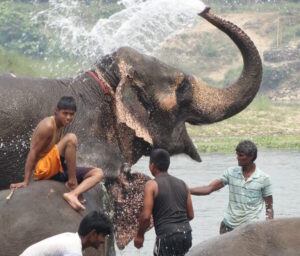Living With Wildlife In Urban Indian Spaces
Jan 20, 2024 | Pratirodh Bureau
A review of research papers on human-wildlife interactions in urban Asia suggests a better understanding of such interactions could help design more inclusive and better urban spaces (Photo by flowcomm/Wikimedia Commons)
- A review of published literature on human-wildlife interactions in Asia, including India, reveals that urban Asia is undergoing rapid land use transformations resulting in frequent encounters between humans and wildlife.
- The review finds that invertebrates, mammals and birds were most commonly featured in the studies in the context of both conflict and coexistence while amphibians, reptiles and fish were the least studied.
- One of the objectives of the review was to expose the complexity of human-wildlife interactions in urban Asia that needed to be taken into consideration while planning sustainable urban designs.

Elephants bathe with people in Chitwan National Park, Nepal. A recent review of scientific papers on human-wildlife interactions in urban Asia reveals potential benefits of such interactions for both humans and animals such as recreation for humans and food resources for animals (Photo by Adam Jones/Flickr)
Human-wildlife interactions in India are often associated with large mammals coming out of the forest and interacting with humans on the fringes of the protected areas. Due to various push and pull factors, the interactions often turn negative and are termed conflicts. Such conflicts are rarely associated with urban areas but a new review of published literature on human-wildlife interactions in urban Asia, including India, reveals that rapid land use transformations can result in frequent encounters with wildlife, especially with species that thrive in urban settings and in the context of changing habitats.
Almost 60 percent of the world’s population lives in Asia, leading to meteoric urbanisation in the Asia-Pacific region with 90 percent of the future urbanisation predicted to be in the region. The region also has almost half of the globe’s biodiversity hotspots, making it impossible to exclude high biodiversity hotspots from land use change, resulting in wildlife habitat loss.
What Does Existing Literature Say About Human-Wildlife Interactions?
The structured review of existing literature on human-wildlife interactions, exposes the complexity of such interactions in urban Asia that need to be considered while planning sustainable urban designs, note the researchers.
The review of 528 papers from Asia, ranging from year 1984 to 2020, finds that invertebrates (in 38% of reviewed studies), mammals and birds (in 27.8 % and 28.9 % of reviewed abstracts, respectively) were most commonly featured in the studies in the context of both conflict and coexistence whereas amphibians, reptiles and fish were the least studied.
Among invertebrates, the studies on butterflies and moths (Lepidoptera 12.4%); sawflies, wasps, ants, bees (Hymenoptera 11.4%); and beetles (Coleoptera 10.9%) were the most common.
The most commonly studied mammals in the abstracts were Carnivora (32%), with large felines, raccoon dogs, bears and canines dominating.
Barring amphibians, the interactions of almost 50 percent of all taxonomic groups were framed as conflicts, the study notes. While humans were considered to be causing conflict in cases of interactions with amphibians, birds, fish and insects, mammals and lizards were the antagonists in the stories of conflicts with humans. The authors maintain that the interactions, whether they were conflicts or coexistence, were contextual and it was difficult to come up with definite causes or solutions for the interactions.
One of the authors of the review, Hannah S. Mumby, a professor at the University of Hong Kong says that the general perception of interactions between humans and wildlife is that they are conflicts, which is not always the case. The review highlights instances of potential benefits from urban human-wildlife interactions for both humans and the animals involved. Humans benefited from the interactions in the form of recreation, improved mental health and ecosystem services provided by the wildlife whereas the animals benefited from increased food resources and connectivity provided by wildlife-friendly gardening practices and urban green spaces. Another key takeaway from the review, according to Mumby, is that certain species like amphibians are not studied enough, leaving a gap that needs to be filled.
Sustainable Urban Design Needs To Be Inclusive
The authors suggest that urban societies should include discussions of human-wildlife interactions as part of their planning processes since urbanisation is rapidly changing the way the landscape looks and causing loss of habitat for many species. The study notes that wildlife conservation and interactions with humans in urban spaces are not routinely included in urban planning for a variety of reasons, including a focus on meeting anthropogenic needs, mixed perception of wildlife interactions and a lack of information readily available for urban designers. “We need to ask ourselves how willing are we to change our own behaviours and perceptions or even give up some conveniences to coexist with wild animals in urban spaces. Our willingness to do so will vary widely if we are talking about species perceived to be harmless or bring benefits (e.g. butterflies) vs those that might pose some danger risk (e.g. bears or other predators),” says Caroline Ding who co-authored the paper.
The study suggests that to incorporate human-wildlife interactions into urban planning and conservation efforts, there needs to be collaboration among wildlife scientists, planners and stakeholders, as well as access to knowledge and data on the types of interactions which occur and the underlying mechanisms determining outcomes. The authors share that one of the aims of the study was to highlight the diversity of work on human-wildlife interactions in Asia and hope that this would encourage more research on the topic globally.
(Published under Creative Commons from Mongabay-India. Read the original article here)
